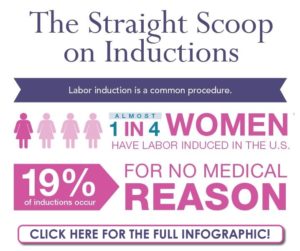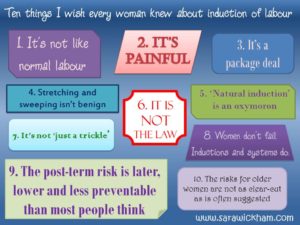Why would I need to be induced?
Labor induction — also known as inducing labor — is the stimulation of uterine contractions during pregnancy before labor begins on its own to achieve a vaginal birth. Your health care provider might recommend inducing labor for various reasons, primarily when there’s concern for a mother’s health or a baby’s health. For example:
- You’re approaching two weeks beyond your due date, and labor hasn’t started naturally (postterm pregnancy)
- Your water has broken, but labor hasn’t begun (premature rupture of membranes)
- You have an infection in your uterus (chorioamnionitis)
- Your baby has stopped growing at the expected pace (fetal growth restriction)
- There’s not enough amniotic fluid surrounding the baby (oligohydramnios)
- You have diabetes
- You have a high blood pressure disorder
- Your placenta peels away from the inner wall of the uterus before delivery — either partially or completely (placental abruption)
- You have a medical condition such as kidney disease or obesity
Can I wait for labor to begin naturally?
Nature typically prepares the cervix for delivery in the most efficient, comfortable way. However, if your health care provider is concerned about your health or your baby’s health or your pregnancy continues two weeks past your due date, inducing labor might be the best option.
Why the concern after two weeks? When a pregnancy lasts longer than 42 weeks, amniotic fluid might begin to decrease and there’s an increased risk of having a baby significantly larger than average (fetal macrosomia). There’s also an increased risk of C-section, fetal inhalation of fecal waste (meconium aspiration) and stillbirth.
Can I request an elective induction?
Elective labor induction is the initiation of labor for convenience in a person with a term pregnancy who doesn’t medically need the intervention. For example, if you live far from the hospital or birthing center or you have a history of rapid deliveries, a scheduled induction might help you avoid an unattended delivery. In such cases, your health care provider will confirm that your baby’s gestational age is at least 39 weeks or older before induction to reduce the risk of health problems for your baby.
Can I do anything to trigger labor on my own?
Probably not.
Techniques such as exercising or having sex to induce labor aren’t backed by scientific evidence. Also, avoid herbal supplements, which could harm your baby.
What are the risks?
Labor induction isn’t for everyone. For example, it might not be an option if you have had a prior C-section with a classical incision or major uterine surgery, your placenta is blocking your cervix (placenta previa), or your baby is lying buttocks first (breech) or sideways (transverse lie) in your uterus.
Inducing labor also carries various risks, including:
- Failed induction. About 75 percent of first-time mothers who are induced will have a successful vaginal delivery. This means that about 25 percent of these women, who often start with an unripened cervix, might need a C-section. Your health care provider will discuss with you the possibility of a need for a C-section.
- Low heart rate. The medications used to induce labor — oxytocin or a prostaglandin — might cause abnormal or excessive contractions, which can diminish your baby’s oxygen supply and lower your baby’s heart rate.
- Infection. Some methods of labor induction, such as rupturing your membranes, might increase the risk of infection for both mother and baby.
- Uterine rupture. This is a rare but serious complication in which your uterus tears open along the scar line from a prior C-section or major uterine surgery. An emergency C-section is needed to prevent life-threatening complications. Your uterus might need to be removed.
- Bleeding after delivery. Labor induction increases the risk that your uterine muscles won’t properly contract after you give birth (uterine atony), which can lead to serious bleeding after delivery.
Inducing labor is a serious decision. Work with your health care provider to make the best choice for you and your baby


